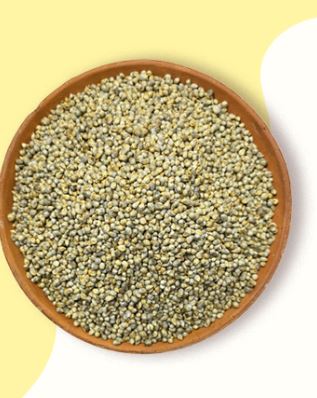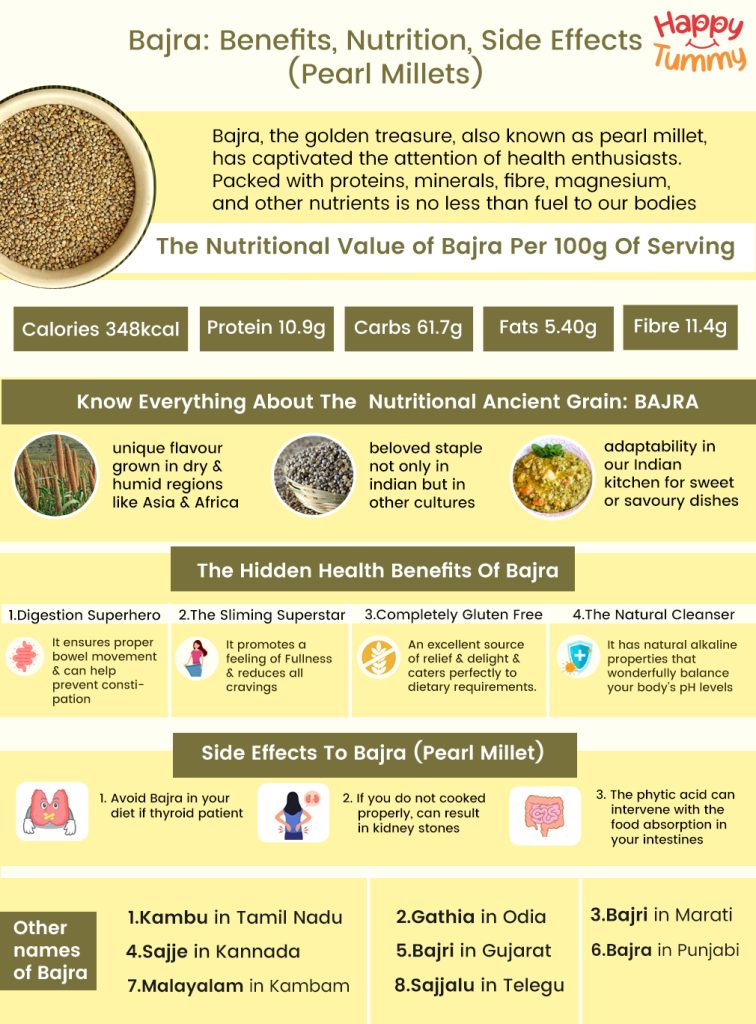Table of Contents
Attention all the weight watchers! Have you heard about bajra – the fascinating grain that has been there for centuries offering nutrition and benefits?
Bajra, the golden treasure, also known as pearl millet, has captivated the attention of health enthusiasts. Packed with proteins, minerals, fibre, magnesium, and other nutrients is no less than fuel to our bodies.
But what makes it different and unique from other food?
This is what we will be learning about in this article. So, let’s dive into the beautiful and exciting journey of pearl millet, a superfood that was long forgotten but coming to life again.
Bajra – Know Everything about the Nutritional Ancient Grain

Certain grains have captivated our taste buds for centuries in these vast culinary delights. One grain that stood out and continues to leave lasting impressions is pearl millet.
The superfood has a unique flavour and an even more remarkable nutritional value chart. This millet has earned its place as a beloved staple not only in Indian culture but in other cultures and cuisines as well.
Pearl millet is grown in humid and dry regions like Asia and Africa. One of the most fascinating nature of this millet is its adaptability in our Indian kitchen.
There are a lot of dishes you can make out of this power-packed and nutritious ingredient. So, whether you add it to savory or sweet dishes, it has always been among the most essential grain in Indian culture.
If you are wondering why you have not heard about this grain, it can be a possibility that you know it by a different name.
It is known as bajra in Hindi but has many other names, such as sajjalu in Telegu, kambu in Tamil Nadu, sajje in Kannada, or bajri in Gujarat. So, now are you able to recall eating this wonderful grain?
Also read – Millets names in different languages
The Nutritional Value of Nature’s Treasure – Bajra
Let’s check some interesting nutritional stats per 100 grams of pearl millet that you eat [1]:
| Nutrients | Value |
| Calories | 348 kcal |
| Protein | 10.9 grams |
| Carbohydrates | 61.78 grams |
| Fats | 5.40 grams |
| Fibre | 11.49 grams |
By now, you are aware of the significance of adding millet to your diet. More important it is to keep track of fibre intake.
To help you with this, Aashirvaad has come up with a comprehensive Meal Plan test where you can check the fibre you’re getting in your everyday meal.
Entering details on your food product will give you the total fibre content of that. So, you will know exactly what you should eat for a happy tummy.
Discovering the Hidden Health Gems Of Pearl Millets

From nourishing our body to offering essential nutrients, pearl millet promotes overall well-being. It provides exceptional health benefits that make it a truly distinctive grain.
So, read along to unlock the secret and hidden health gems of this delicious and super healthy power grain – bajra.
1. Bajra, The Digestion Superhero
When it comes to digestive health, nobody wants to take a chance. After all, good digestive health is the way to excellent overall health. And when it’s about taking care of your gut, bajra emerges as a true champion [2].
It is packed with dietary fibre and is a natural aid to your digestive health. The excellent fibre content ensures proper bowel movement and can help prevent constipation.
Pearl millet is also a prebiotic agent and aids in increasing the healthy and good gut bacteria in our stomach.
You will eventually have the best digestive system if you have more good gut bacteria. It will further help you absorb all your food nutrients and strengthen digestion.
If you often face digestion issues, you should go for this fantastic digestive quotient test, introduced by expert nutritionists. A simple 2- minute test will give you a digestive score out of 100. So, what are you waiting for? Go for it now.
2. Pearl Millet, The Delight For The Gluten-Allergic
Are you on a gluten-free journey or allergic to gluten and looking for alternatives? Try pearl millet, your new gluten-friendly friend. Pearl millet is a haven for people who are gluten-allergic [3].
It is an excellent source of relief and delight and caters perfectly to dietary requirements. From soft rotis to cake and muffins, you can make everything from pearl millet flour. It solves the gluten problem and adds flavour to your food.
So, now remember, if you want an easy option to enjoy a gluten-free diet, switch to Aashirvaad Multi Millet Mix, which comes with the goodness of some vital millet grains that are best for your family’s health.
It is naturally gluten-free, rich in protein, and a complete source of nutrition.
3. Bajra, The Sliming Superstar
Weight control is a widespread discussion, and everyone is searching the internet for some good, delicious, and healthy recipes and ingredients.
Pearl millet is a true slimming superstar for weight control management [4]. It has some excellent qualities, making it an ally for your perfect weight.
Since it has an abundance of dietary fibre, it promotes a feeling of fullness and reduces all cravings, thus, helping you stay satisfied for a more extended period. You can easily include it as your snack and make it your weight loss hero.
4. Pearl Millet, The Natural Cleanser
If you are someone who wants healthy and clearer skin without going for harsh chemicals, add bajra to your diet. It is your perfect ingredient to rejuvenate and clean your body.
It has natural alkaline properties that wonderfully balance your body’s pH levels. While its antioxidants help combat harmful free radicals and thus help protect your cells from damage.
Adding this power-packed little grain to your diet will add a natural cleanser and detoxifier to your lifestyle.
5. Bajra, The Bone Booster
Anyone who experiences joint pains should consider adding bajra to their diet.
Pearl millet is rich in phosphorous and calcium that your body needs for healthy and strong bones.
You will not believe it, but bajra is a bone-boosting superstar. It is a great ingredient providing the building blocks needed for healthy bones.
Are There Any Side Effects To This Wonderful Grain, Pearl Millet?
Bajra is considered to be safe and highly beneficial for most people, but still, there can be some who may face some trouble using this ingredient. We have listed some for your reference, and if you face a situation where you experience any of the below, rush to the nearest doctor.
- If you are a thyroid patient, avoid using this in your diet or check with your doctor before adding it to your meal plans. It can intervene with your symptoms and cause further issues, so it is better to consult and start.
- If you do not cook pearl millet properly, the oxalates in the ingredient can result in kidney stones, while the phytic acid can intervene with the food absorption in your intestines.
Bottom Line
To conclude, pearl millet is one of the most versatile grains with rich culinary history. It has immense benefits and holds much value and significance in Indian culture.
Whether you wish to go on a gluten-free diet or achieve holistic well-being, bajra can solve your problems. You can infuse this small little grain in your kitchen in many ways and start your pursuit of a happy tummy and vibrant life.
FAQs
Bajra is a healthy grain that is fibrous, rich in protein, gluten-free and good for health. People with gluten allergies and those looking for a protein-rich diet can easily consume it.
Pearl millet or bajra acts as a hot element for the body. It is loaded with starch which is used to be converted into energy, promotes healthy blood circulation, and hence it is known to increase the body temperature.
Pearl millet comes in the food category of alkaline and is a perfect ingredient to fight acidity issues. Heartburn generally happens when there is excess gas in your body. You can mix bajra with vegetables to relieve heartburn in your diet.
Yes, eating bajra daily is fine. You can use it to make chapatti, dosa, porridge, and even snacks such as cookies. You can consult a doctor if you face problems after eating pearl millet.
Since bajra possesses natural hot properties, it is an ideal ingredient for winter. Mix it with buttermilk to make a cool summer drink by reducing heat if you want to consume it during summer.
People with thyroid issues should prefer not to consume products made of pearl millet or flour. You can also check with your doctor about the necessary precautions, if any, to be taken if you are planning to add it to your diet.
















